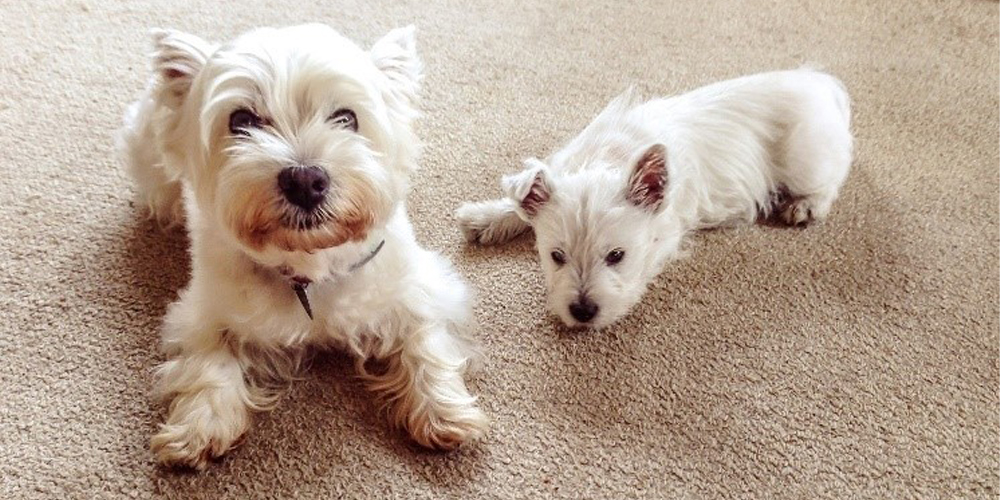
Puppy Love! A guide to successful introductions with your older pet
16th November, 2023
Images of pooch pals are all around us. Dogs play together in TV ads while our Instagram feeds are full of snuggling pups. The reality of relationships between dogs in the same household can be different. While some dogs become firm friends soon after meeting, other relationships can take longer to blossom.
Some dogs may never get on well, but there is lots you can do to move things in the right direction. If you’re considering getting another dog or will be welcoming one soon, this guide is for you.
Get expert advice early on
Although you’d love your dogs to become the best of pals, each dog is an individual and some will always prefer their own space and company. An-elderly dog for example, may not welcome a bouncy puppy into the household.
It’s a good idea to get advice from a qualified dog behaviourist or trainer before you start looking for a dog or puppy. They should help you identify the kind of dog that would be a good fit in your household and help both dogs with the transition of the new situation. There are a lot of benefits to engaging a behaviourist or trainer early on.
Ensure all the dog’s vaccinations are up to date
You want all your dogs to be safe and well. That’s why it’s important that their vaccinations are up to date before they meet. Otherwise, they could pass infections to one another.
A puppy will be vulnerable to infection from your existing dog until at least one week after they’ve completed their puppy vaccination course. You’ll need to ensure your current dog is up to date with their vaccinations before you bring your new puppy home.
Not sure about the vaccination status of any of the dogs? Check with your vet (for your current dog) or with the seller or rehoming centre (for your new pooch).
Arrange a meet up
If you’re getting your dog from a private buyer, see if it is possible for the two dogs to meet on neutral ground before you commit to buy. This allows the dogs time and space to get introduced to each other in a safe and appropriate way. It’ll help you get a sense of whether they might be a good fit to live with each other.
If you’re adopting, the rehoming centre will arrange for your whole family to meet your potential adoptive dog – including your current dog(s). This helps set both dogs up for success by first introducing them on neutral ground and allowing them to build the foundations for a happy life together.
Get set up before the dogs meet
Get prepared for the dogs first meeting in your house. If your current dog’s bowls or bedding will be in a different place when your new dog arrives, it’s a good idea to prepare them by moving their things a few days in advance.
On the day your new dog will be arriving, pack away your current dogs toys, bedding and food bowls for a while to avoid competition over them. Once you’ve got past the first meeting and first hour or two together, you should lay out each dogs bowls and bedding in separate areas of the house. This way each can eat, drink and rest alone in peace.
What to do if tensions arise
Dogs growl as a warning that they need some space- its natural behaviour. If your adult dog growls at your puppy or shows signs of discomfort such as lunging or snapping, encourage your puppy to move away from your dog and give them something fun to do in their own safe space.
If your puppy has been injured, seek veterinary advice straight away. Get advice from a qualified behaviourist or trainer before attempting another introduction.
Should your puppy seem nervous or worried, call the adult dog away and engage them with something else. Provide them with something fun, such as food, treats or attention away from the puppy. Give both dogs some breaks in the interaction, so it isn’t prolonged.
The start of a lifetime of friendship
With careful handling, the first meeting between your new and your current dog could be the start of a beautiful friendship. Your faithful friends could soon be playing in the park and snuggling together on the sofa.
Remember, though, that every dog is an individual with their own unique needs and preferences. Some dogs would love the company of another dog, while others will always prefer to have their own space.
By taking introductions slowly and at each dog’s pace you have the best chance to make sure it is a good fit for them both and set them up for a successful life together. It also allows you to have the time to identify any potential issues before they become problems.
With some good advice behind you and a patient approach, your dogs should soon be on the right path together.